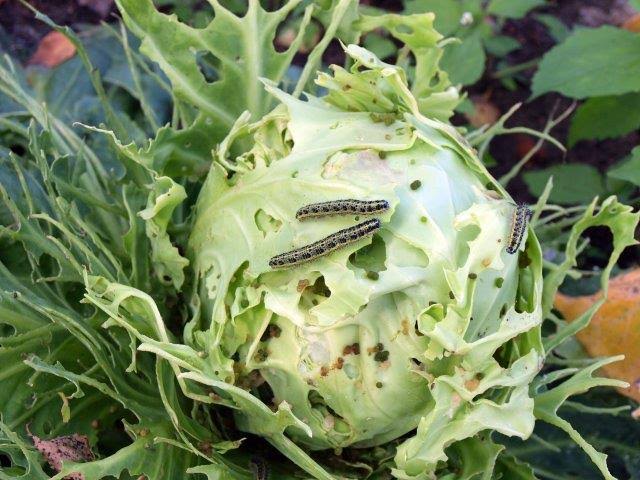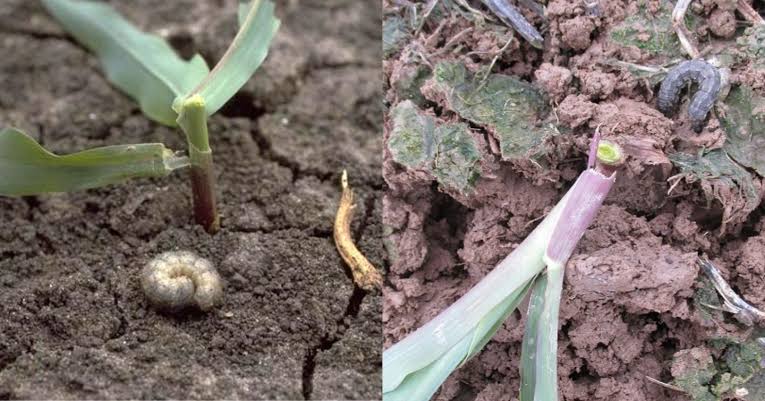Cutworms: Description, Damages Caused, Control and Preventive Measures
Cutworms scientifically known as Noctuidae are caterpillars that can cause damage to various plants, these insects are part of the larger family of moths known as Noctuidae. Cutworms earned their name due to their feeding behavior, which involves cutting through the stems of young plants near ground level.
These caterpillars are nocturnal, meaning they are active during the night. They hide in the soil during the day and emerge at night to feed on a wide range of plants. Cutworms are known for their voracious appetite, and they can cause significant damage to crops and garden plants.
One of the challenges with managing cutworms is their ability to disguise themselves in the soil, making them difficult to detect. As they feed on plants, they may sever the stems, causing young plants to wilt or die. This can be particularly problematic for farmers and gardeners, as it can lead to reduced crop yields and plant losses.
There are various species of cutworms, and they may have different preferences for plants they feed on. Some common types include the black cutworm (Agrotis ipsilon), variegated cutworm (Peridroma saucia), and armyworms, which are also a type of cutworm.
Controlling cutworms requires a combination of preventive and management strategies. Practices such as crop rotation, proper sanitation, and timely planting can help reduce the risk of cutworm infestations. In addition, natural predators like parasitic wasps and birds play a role in keeping cutworm populations in check.
Chemical control methods, such as the use of insecticides, can also be employed. However, it’s essential to use these substances judiciously, considering their potential impact on the environment and non-target organisms.
Understanding the life cycle of cutworms is crucial for effective management. Adult moths lay eggs on the soil, and when these eggs hatch, the larvae (cutworms) begin their feeding activity. As they mature, cutworms pupate in the soil before emerging as adult moths to continue the cycle.
While cutworms pose a threat to plants and crops, adopting integrated pest management strategies that encompass cultural, biological, and chemical methods can help mitigate their impact. Awareness of their life cycle and habits is essential for implementing effective control measures and safeguarding agricultural and horticultural endeavors from the damage caused by these nocturnal pests.
Trad Also: Gooseberries: History, Nutrition, Health Benefits and Growing Guide
Plants Affected by Cutworms (Noctuidae)

Cutworms can affect a wide variety of plants, causing damage to both cultivated crops and ornamental plants. Some of the plants commonly affected by cutworms include vegetables, fruits, and other garden plants. Common targets for cutworm feeding include:
1. Vegetables:
Tomatoes: Cutworms may target young tomato plants, cutting through their stems near the ground.
Cabbage and other Brassicas: Cutworms are known to feed on cabbage, broccoli, cauliflower, and other members of the Brassicaceae family.
Peppers: Young pepper plants are susceptible to cutworm damage, especially during the early stages of growth.
Lettuce: Cutworms can pose a threat to young lettuce plants, affecting their development.
2. Fruits:
Strawberries: Cutworms may target strawberry plants, affecting both fruit production and overall plant health.
Berries: Various berry plants, such as raspberry and blackberry bushes, can be vulnerable to cutworm damage.
Apple and Pear Trees: While less common, cutworms may also pose a threat to young fruit tree seedlings.
3. Ornamental Plants:
Flowering Plants: Cutworms can impact a range of flowering plants, including annuals and perennials, by cutting through stems near the base.
Ornamental Shrubs: Some cutworm species may feed on the tender shoots of ornamental shrubs, affecting their growth and appearance.
4. Crops:
Corn: Cutworms, especially the black cutworm, can be a significant concern in cornfields, causing damage to young corn plants.
Soybeans: Cutworms may also affect soybean crops, impacting seedling development.
5. Herbs:
Parsley, Dill, and Cilantro: Herbs like parsley, dill, and cilantro are susceptible to cutworm damage, particularly in their early growth stages.
It’s important for gardeners and farmers to be vigilant and monitor their plants for signs of cutworm damage. Early detection allows for timely intervention and helps prevent extensive harm to crops and ornamental plants. Implementing preventive measures and employing integrated pest management practices can contribute to effective cutworm control in diverse plant environments.
Damages Caused by Cutworms

Cutworms can cause various damages to plants, affecting both agricultural crops and ornamental vegetation. The primary mode of damage is the cutting of plant stems near the ground, but the consequences extend beyond physical injury. Here are the key damages caused by cutworms:
1. Stem Cutting: Cutworms are notorious for their habit of cutting through the stems of young plants, often at ground level. This can lead to wilting, lodging, or the complete destruction of seedlings.
2. Reduced Plant Growth: The act of severing plant stems disrupts the normal growth and development of affected plants. This stunting can result in diminished crop yields for agricultural crops or negatively impact the aesthetic appeal of ornamental plants.
3. Crop Losses: In agricultural settings, cutworms can cause significant economic losses by damaging crops such as corn, soybeans, tomatoes, and various vegetables. Reduced plant stands and weakened plants contribute to decreased overall crop productivity.
4. Impact on Seedlings: Young seedlings are particularly vulnerable to cutworm damage. The loss of these early-stage plants can set back planting schedules and require replanting efforts.
5. Feeding on Foliage: While the primary damage is inflicted on plant stems, cutworms may also feed on the foliage of certain plants. This additional feeding can contribute to overall stress and reduced plant vitality.
6. Tunneling in Soil: Some cutworm species exhibit behavior such as tunneling in the soil during the day. This activity can disrupt root systems and create an environment conducive to other soilborne pests and diseases.
7. Aesthetic Damage to Gardens: In ornamental gardens, cutworm damage can affect the visual appeal of flower beds and landscaped areas. Unsightly gaps in plantings and damaged foliage can detract from the overall beauty of the garden.
8. Pest-Induced Stress: Cutworm infestations can induce stress in plants, making them more susceptible to other pests and diseases. Weakened plants may struggle to resist additional environmental challenges.
9. Increased Vulnerability to Environmental Stress: Plants damaged by cutworms become more vulnerable to environmental stresses such as drought, extreme temperatures, and nutrient deficiencies, further compromising their health and resilience.
10. Interference with Crop Rotation Plans: In agricultural systems, cutworm damage may disrupt crop rotation plans, as replanting or addressing the consequences of reduced plant stands becomes necessary.
Effective management strategies, including monitoring, early detection, and integrated pest control methods, are crucial to minimizing the damages caused by cutworms and preserving the health and productivity of plants.
Read Also: Blackcurrants: History, Nutrition, Health Benefits and Growing Guide
Control and Preventive Measures

Controlling and preventing cutworm infestations involves a combination of strategies that address their life cycle, feeding habits, and habitat. Here are some effective measures for managing cutworms:
1. Crop Rotation: Practice crop rotation to disrupt the life cycle of cutworms. Moving crops to different locations each season can help reduce the availability of host plants for cutworms.
2. Tillage Practices: Implement proper tillage practices to expose cutworm pupae to natural predators and environmental conditions that can hinder their survival.
3. Clean Cultivation: Maintain clean cultivation practices by removing plant debris and weeds, as these can provide hiding places for cutworms during the day.
4. Biological Control: Encourage natural predators such as parasitic wasps, ground beetles, and birds that feed on cutworms. Protecting and promoting a diverse ecosystem can enhance biological control.
5. Beneficial Nematodes: Apply beneficial nematodes to the soil. These microscopic organisms are natural enemies of cutworms and can help in reducing their populations.
6. Bt (Bacillus thuringiensis) Products: Use Bt-based insecticides, which are effective against cutworms and safe for non-target organisms. Bt produces proteins toxic to certain insect larvae.
7. Traps and Barriers: Set up traps, like pheromone traps, to monitor cutworm activity. Physical barriers, such as collars or cardboard barriers around seedlings, can also prevent cutworm access.
8. Planting Time Management: Time planting to avoid peak cutworm activity. Planting crops later in the season when cutworms are less active can help minimize damage.
9. Companion Planting: Utilize companion planting strategies by growing plants that repel or distract cutworms near susceptible crops. For example, planting marigolds or onions around vegetables can be beneficial.
10. Chemical Control: If necessary, use chemical insecticides with caution. Apply insecticides specifically labeled for cutworm control and follow recommended application rates and guidelines. Focus on targeted areas to minimize environmental impact.
11. Vigilant Monitoring: Regularly inspect plants for cutworm damage and the presence of larvae. Early detection allows for prompt intervention before significant damage occurs.
12. Natural Mulches: Apply natural mulches, such as straw or wood chips, around plants to make the soil less attractive to egg-laying moths and disrupt the cutworm’s access to plant stems.
Implementing a combination of these measures in an integrated pest management approach can help control cutworm populations effectively while minimizing the reliance on chemical solutions. Tailoring strategies to the specific needs of the crop and local conditions is essential for successful cutworm management.
Frequently Asked Questions (FAQs) About Cutworms (Noctuidae)
Q1: What are cutworms, and why are they called “cutworms”?
A1: Cutworms are caterpillars belonging to the Noctuidae family of moths. They are called “cutworms” because of their feeding behavior, which involves cutting through the stems of young plants near ground level.
Q2: Which plants are most susceptible to cutworm damage?
A2: Cutworms can affect a wide range of plants. Commonly affected plants include vegetables like tomatoes, cabbage, and peppers, fruits such as strawberries and berries, ornamental plants, and crops like corn and soybeans.
Q3: How can I identify cutworm damage on my plants?
A3: Look for cut stems near the soil surface. Cutworms often feed during the night, and the damage may cause wilting or lodging of young plants. Check for the presence of caterpillars in the soil around affected plants.
Q4: Are there natural predators that can help control cutworm populations?
A4: Yes, natural predators like parasitic wasps, ground beetles, and certain birds feed on cutworms. Encouraging a diverse ecosystem in your garden or field can enhance biological control.
Q5: What preventive measures can I take to avoid cutworm infestations?
A5: Practice crop rotation, till the soil to expose pupae, maintain clean cultivation, and encourage natural predators. Timing planting to avoid peak cutworm activity and using barriers like collars or traps are also effective preventive measures.
Q6: Can cutworms be controlled without using chemical insecticides?
A6: Yes, cutworms can be controlled through various non-chemical methods, such as biological control, natural predators, traps, and cultural practices. Chemical control should be considered as a last resort, and if used, it should be done judiciously.
Q7: What is the life cycle of cutworms, and how can it be disrupted?
A7: Cutworms go through egg, larva (caterpillar), pupa, and adult stages. Crop rotation, tillage practices, and biological control methods can disrupt their life cycle by targeting eggs, larvae, and pupae.
Q8: Are there specific insecticides effective against cutworms?
A8: Insecticides containing Bacillus thuringiensis (Bt) are effective against cutworms. It’s important to use insecticides labeled for cutworm control and follow recommended application rates.
Q9: Can mulching help in preventing cutworm infestations?
A9: Yes, applying natural mulches, such as straw or wood chips, around plants can make the soil less attractive to egg-laying moths and disrupt cutworm access to plant stems.
Q10: What should I do if I notice cutworm damage on my plants?
A10: Take prompt action by implementing control measures based on the severity of the infestation. This may include using biological control methods, setting traps, or applying insecticides as a last resort. Regular monitoring is crucial for early detection and intervention.
Read Also: How to Make Your Own Organic Pesticides









